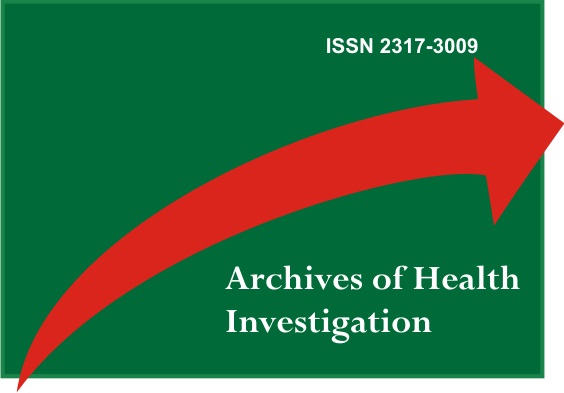The influence of the dentist during the treatment of oral squamous carcinoma: case report
DOI:
https://doi.org/10.21270/archi.v10i6.5050Keywords:
Carcinoma, Squamous Cell, Leukoplakia, Oral, Mouth MucosaAbstract
Background: Squamous cell carcinoma (SCC) represents the most common malignant neoplasm of the mouth which affects mainly subjects over 50 years of age. Clinically it usually presents as persistent ulcers with hardened edges, that may be associated with vegetation, erythroplastic or leukoplastic plaques. The most affected sites are the lateral edge of the tongue and the oral floor. Objective: to report a clinical case of microinvasive SCC on the tongue, emphasizing the importance of early diagnosis and follow-up by the dentist during and after cancer treatment. Case presentation: A 42-years-old male patient showed a leucoplasic plaque on the right side edge of the tongue, with diameter approximately 2,0 cm, rough surface, irregular contours and well-defined limits, which had appeared about two months ago. Under a diagnostic hypothesis of oral leukoplakia, an incisional biopsy was performed and the histopathological outcomes showed CCE microinvestment. The final diagnosis of SCC predominantly in situ was observed after radical surgery removal of the lesion. The patient preceded the cancer treatment with radiotherapy and was followed-up during the transoperative period by the group of dentists to prevent and treat the complications resulting from the radiotherapy. The patient showed no signs of recurrence after one year and remains in monitoring. Closing remarks: Early diagnosis was primordial for the good prognosis of the disease. In addition, the performance of the dentist group was very important during the cancer treatment.
Downloads
References
Brabyn PJ, Naval L, Zylberberg I, Muñoz-Guerra MF. Oral squamous cell carcinoma after dental implant treatment. Rev Esp Cir Oral Maxilofac. 2018; 40(4):176-86.
Salgado-Peralvo AO, Arriba-Fuente L, Mateos-Moreno MV, Salgado-Garcia A. Is there na association between dental implants and squamous cell carcinoma?. Br. Dent. J. 2016; 221 (10): 645-9.
Rikardsen OG, Bjerkli I, Uhlin-Hansen L, Hadler-Olsen E, Steigen S. Clinicopathological characteristics of oral squamous cell carcinoma in Northern Norway: a retrospective study. BMC Oral Health. 2014; 14 (1): 103.
Wunsch Filho V, Mirra AP, Lopez RVM, Antunes LF. Tabagismo e câncer no Brasil: evidências e perspectivas. Rev Bras Epidemiol. 2010;13(2):175-87.
Omura K. Current status of oral câncer treatment strategies: surgical treatments for oral squamous cell carcinoma. Int J Clin Oncol. 2014;19(3):423-30.
Hespanhol FL, Tinoco EMB, Teixeira HGC, Falabella MEV, Assis NMSP. Manifestações bucais em pacientes submetidos à quimioterapia. Cien Saúde Colet. 2010; 15(1):1085-94.
Martins de Castro RF, Dezotti MSG, Azevedo LR, Aquilante AG, Xavier CRG. Atenção odontológica aos pacientes oncológicos antes, durante e depois do tratamento antineoplásico. Rev Odontol UNICID. 2002;14(1):63-74.
Llewellyn CD, Johnson NW, Warnakulasuriya KAAS. Risk factors for squamous cell carcinoma of the oral cavity in young people – a comprehensive literature review. Oral oncology. 2001;37(5):410-18.
Miller AB, Hoogstraten B, Staquet M, Winkler A. Reporting results of cancer treatment. Cancer. 1981;47(1):207-14.
Mignogna MD, Fedele S, Russo LL. The world cancer report and the burden of oral cancer. Eur J Cancer Prev. 2004;13(2):139-42.
Chin D, Boyle GM, Porceddu S, Theile DR, Parsons PG, Coman WB. Head and neck cancer: past, present and future. Expert Rev Anticancer Ther. 2006;6(7):1111-18.
World Health Organization. World Cancer Report 2014. Lyon: International Agency for Research on Cancer. 2015:423.
Dewan AK, Dabas SK, Pradhan T, Mehtá S, Dewan A, Sinha. Squamous cell carcinoma of the superior gingivobuccal sulcus: an 11-year institional experience of 203 cases. Jpn J Clin Oncol. 2014;44(9):807-11.
Durazzo MD, Araujo CEN, Brandão-Neto JS, Potenza AS, Costa P, Takeda F, et al. Clinical and epidemiological features of oral cancer in a medical school teaching hospital from 1994 to 2002: increasing incidence in women, predominance of advanced local disease, and low incidence of neck metastases. Clinics. 2005;60(4):293-8.
Hamada GS, Bos AJ, Kasuga H, Hirayama T. Comparative epidemiology of oral cancer in Brazil and India. Tokai J Exp Clin Med. 2011;16(1):63-72.
Güneri P, Çankaya H, Yavuzer A, Güneri EA, Erisen L, Özkul D, et al. Primary oral cancer in a Turkish population sample: association with sociodemographic features, smoking, alcohol, diet and dentition. Oral Cancer. 2005; 41(10):1005-12.
Borges DML, Sena MFS, Ferreira MAF, Roncalli AG. Mortality for oral cancer and socioeconomic status in Brazil. Cad Saúde Pub. 2009;25(2):321-27.
Antunes AA, Takano JH, Queiroz TC, Vidal AKL. Perfil epidemiológico do câncer bucal no CEON/UPE e HCP. Odontologia Clín Cientif. 2003;2(3):181-86.
Gervásio OLAS, Dutra RA, Tartaglia SMA, Vasconcellos WA, Barbosa AA, Aguiar MCF. Oral squamous cell carcinoma: a retrospective study of 740 cases in brazilian population. Braz Dent J. 2001;12(1):57-61.
Radoï L, Luce D. A review of risk factors for oral cavity cancer: the importance of a standardized case definition. Community Dent Oral Epidemiol. 2013;41(2):97-109.
Dedivitis RA, França CM, Mafra ACB, Guimarães FT, Guimarães AV. Características clinico-epidemiológicas no carcinoma espinocelular e boca e orofaringe. Rev Bras Otorrinolaringol. 2014;70(1):35-40.
Chambers MS, Garden AS, Kies MS, Martin JW. Radiation-induced xerostomia in patients with head and neck cancer: pathogenesis, impact on quality of life, and management. Head and neck. 2004;26:796-807.
Rubira CMF, Devides NJ, Úbeda LT, Bortolucci Jr, Lauris JR, Rubira-Bullen IZR, et al. Evaluation of some oral postradiotherapy sequelae in patients treated for head and neck tumors. Braz.. Oral Res. 2007;26(1):272-77.
Sennhenn-Kirchner S, Friederike F, Grundmann S, Martin A, Zapelin MB, Christiansen H, et al. Dental therapy before and after radiotherapy – an evaluation on patients with head and neck malignancies. Clin Oral Investing. 2009;2:156-64.
Jham BC, Freire ARS. Oral complications of radiotherapy in the head and neck. Rev Bras Otorrinolaringol. 2006;72(5):704-8.
Robertson AG, Soutar DS, Burns H, Robertson C. Treatment of oral cancer: the need for defined protocols and specialist centres. Variations in the treatment of oral cancer. Clin Oncol. 2011;2(13):409-15.


